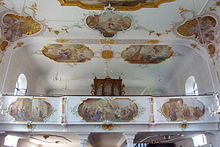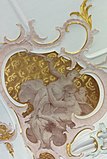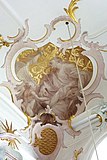St. Nikolaus (Deisenhofen)
The Catholic parish church of St. Nikolaus in Deisenhofen , a district of Höchstädt in the district of Dillingen an der Donau in the Bavarian administrative district of Swabia , was built at the end of the 17th century on the site of a previous building from the 15th century. In the middle of the 18th century, the interior was renewed in the Rococo style. The church, dedicated to St. Nicholas of Myra , has frescoes by Johann Anwander .
history
Deisenhofen was initially under the parish of the mother settlement Mörslingen . A chapel in Deisenhofen is mentioned in a document from 1338 . The first church was built in the 15th century, of which the square basement of the tower has been preserved. The present nave was built in 1692 and the altars were built in around 1700 . In 1710 the tower was raised with an octagon and covered with an onion dome . In 1760 the church received a new interior in the Rococo style and was decorated with frescoes and stucco decorations . In 1858 the nave was extended four meters to the west. In 1867 Deisenhofen became its own parish. The sacristy was added in 1873/75. In 1980/81 the church was renovated outside and in 1986/87 inside. Another renovation took place in 2017.
architecture
Exterior construction
The outer walls are divided into glare fields, delimited by pilaster strips and arches, into which large arched windows are cut. A profiled eaves cornice runs under the roof approach .
The square, five-storey substructure of the tower is pierced by narrow slits and at the top by round-arched twin windows. The two-storey octagonal structure, which is covered with an onion helmet, is reinforced with corner pilasters and interrupted in the lower part by arched sound arcades . On the top floor, dazzle fields alternate with clock faces.
The year 1692 is carved over the south portal of the church. It is reminiscent of the start of construction on today's nave.
inner space
The nave of the single-nave choir tower church is divided into five axes and is covered by a flat ceiling over a throat. In the east, a wicker-arched choir arch opens to the retracted, square choir with groin vault . Western concludes with a two pillars resting dais on which the organ is housed.
Piece
The ceilings and walls are covered with rich stucco decor. Elegant shell work frames the frescoes and decorates the choir arch, the arches over the windows and the gallery parapet.
Ceiling and wall painting
The frescoes of the nave and the gallery balustrade was 1760 from that in Lauingen resident Johann Anwander running (1715-1770). The large fresco in the nave depicts the transfiguration of St. Nicholas, the patron saint of the church. Greek deities symbolize the four elements on the edges . The fresco is inscribed: “Joh. Anwander inv. & Pinx. 1760 ”(Johann Anwander designed and painted it). The frescoes in the throats have scenes from the life of St. Nicholas on the subject, such as his help for seafarers in distress or the rescue of the innocent condemned to death. The grisailles in the corners contain allegorical representations of the virtues .
The ceiling frescoes above the gallery depict King David playing the harp and St. Cecilia of Rome at the organ. The frescoes on the gallery balustrade tell episodes from the life of St. Nicholas. On the left, Nicholas enters a church and is then elected bishop; on the right, he encourages Roman officers accused of lese majesty. In the middle the worship of the patron saint by the believers is shown.
The choir fresco depicting the monstrance held by angels is attributed to an unknown painter.
Furnishing
- A crucifixion group from around 1700 is located under a stuccoed canopy .
- The high altar and the two side altars date from around 1690/1700. The altar leaves were made by Johann Anwander. The high altar picture is dedicated to St. Nicholas, the northern altar panel depicts Mary of Victory , the southern altar panel Anna Selbdritt . The two wooden figures of the high altar, John the Baptist and St. Joseph , are dated around 1720.
- The sculpture of St. Leonhard is a Swabian work from the first half of the 18th century.
- The sculpture of St. Sebastian in the choir is dated to the middle of the 18th century.
- The pulpit was created around 1760. It is adorned with the symbols of the evangelists . The sound cover is crowned by the tablets of the law , which are carried by putti heads. The image of the apostle Peter on the front of the oval body is attributed to Johann Anwander.
literature
- Georg Dehio : Handbook of German Art Monuments - Bavaria III - Swabia (arr.: Bruno Bushart, Georg Paula) . 2nd Edition. Deutscher Kunstverlag , Munich 1989, ISBN 3-422-03008-5 , p. 232-233 .
- Werner Meyer (arrangement): The art monuments of the district of Dillingen on the Danube . In: The art monuments of Bavaria. The art monuments of Swabia. Vol. VII. District of Dillingen on the Danube . Munich 1972, ISBN 3-486-43541-8 , pp. 196-201.
- Georg Wörishofer, Alfred Sigg, Reinhard H. Seitz: Cities, Markets and Communities . In: The district of Dillingen ad Donau in the past and present . Edited by Landkreis Dillingen an drt Donau, 3rd revised edition, Dillingen an der Donau 2005, p. 300.
Web links
Individual evidence
- ^ Parish of St. Nikolaus, Diocese of Augsburg
Coordinates: 48 ° 37 ′ 7 ″ N , 10 ° 32 ′ 19 ″ E








